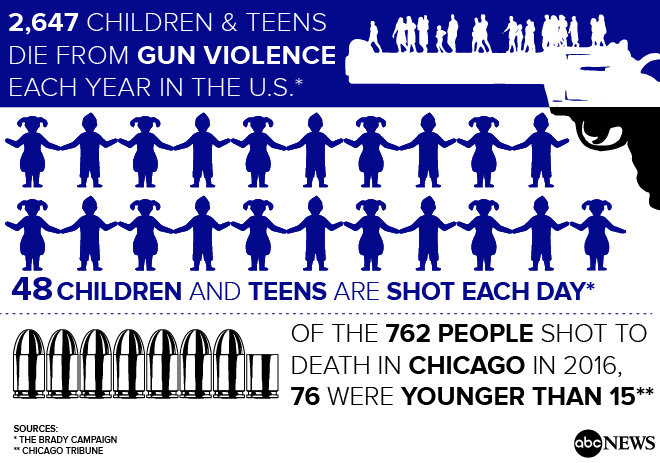America’s Youth Under Fire
The Devastating Impact of Gun Violence on Young People

Introduction and summary
On February 14, 2018, 14 students and three staff members were murdered at Marjory Stoneman Douglas High School in Parkland, Florida, by a single shooter armed with an assault rifle. This horrific massacre galvanized the nation’s attention to the issue of gun violence, particularly as it affects young people in this country. However, the scope of gun violence as it affects America’s youth is much vaster than this most recent mass shooting. Gunfire has officially overtaken car accidents as one of the leading killers of young people in the United States.1 As of publication time, since the beginning of 2018, 820 teens ages 12 to 17 have been killed or injured with a gun.2 As mass shootings become more common and more deadly, a staggering 57 percent of teenagers now fear a school shooting.3
The epidemic of gun violence against America’s youth is more than just a disturbing data point. For each bullet fired, there are multiple stories of lives changed forever. When he was just 6 years old, Missouri State Rep. Bruce Franks Jr. saw his brother shot in front of their neighbor’s home.4Nevada activist Mariam El-Haj witnessed the shooting of her mother by her estranged father, who then turned the gun on Mariam.5 Oregon youth mentor Jes Phillip’s siblings have all had close calls—she has three younger sisters who were present at the Reynolds High School shooting in Troutdale, Oregon, and two bullets landed next to her brother’s bed when they came through her family’s apartment wall during a neighborhood shooting.6 Nineteen- year-old student Eli Saldana, a member of the Native American community living in Chicago, was shot on his walk home from work.
These stories of gun violence are all too common among young Americans. The United States’ gun violence epidemic disproportionately ravages young people, particularly young people of color. In short, gun violence is shattering a generation.
Young people are not simply victims of gun violence in this country, they are among the leading voices calling for change to the nation’s weak gun laws and deadly gun culture. Organizers of the Black Lives Matter movement; survivors of the Parkland shooting; youth organizers working in cities hardest hit by gun violence, such as Chicago, Baltimore, and St. Louis, have all lent their voices to an increasingly loud call to action.
These young people do not just want to reform gun laws—they are also demanding that the issue of gun violence be examined as part of a complex and intersectional web of issues that also include community disinvestment, criminal justice reform, and policing. They are advocating not only for solutions to make schools safer from mass shootings but also for holistic and intersectional solutions that will help make all communities safer.
This report breaks down how gun violence is affecting young people, and how young activists are rising to build an intersectional movement working for solutions. It examines the specific impact of gun violence on young people and considers both how young people as a collective are disproportionately affected and how different communities of young people share different aspects of the burden of this violence. This report also highlights examples of young people leading the advocacy efforts around this issue and discusses a number of policy solutions that are crucial to reducing gun violence, reforming the criminal justice system, improving police-community relations, and encouraging reinvestment in impacted communities.


Impact of gun violence on young people: A national overview
Young people make up a very small percentage of all deaths in the United States each year. Consider 2016: That year, more than 2.7 million people in the United States died, with the top-three leading causes of death being heart disease, cancer, and unintentional injuries.7 Of these 2.7 million deaths, only 2.2 percent were individuals between the ages of 15 and 29.8However, looking only at deaths caused by gunfire, the picture changes dramatically. Young people in this age range Continue reading: America’s Youth Under Fire - Center for American Progress:









